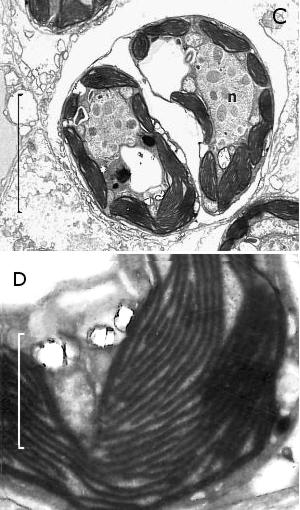

What are Zooxanthellae?
PHOTO
See details at bottom of page.
Zooxanthellae are single-celled plants that live in the tissues of animals. They are dinoflagellates, a group of microscopic plants which are usually found swimming and floating in the sea. Organisms which live like this are called plankton, and those that are plants are called phytoplankton. Like most plants, phytoplankton are able to convert the sun's energy into food through a process called photosythesis, so to survive they are only found in the upper layers of the sea and lakes where sunlight can penetrate.
Zooxanthellae are best known for their role in the life of reef-forming corals. In tropical waters almost all coral animals contain a colony of zooxanthellae. Without these symbiotic plants, the coral animals would be unable to obtain enough nutrients to build their calcium carbonate skeletons, which accumulate to form the vast coral reefs of the tropics.
Coral animals and other related cnidarians (corals, soft-corals, sea anemones, gorgonians etc) are the most well-known animals containing symbiotic zooxanthellae, but they are also found in other invertebrates such as the Giant Clams (Tridacna) and many nudibranchs. Just as in their free-living relatives, zooxanthellae need to live in the sunlight, so they are usually found in those parts of animals, such as the skin, which are in the sunlight.
Because they are so small we can only study their structure with the help of an electron microscope. Here are some photos of zooxanthellae living in nudibranchs. To see all the parts of the zooxanthellae, we have to cut it into very thin slices, and then photograph each slice. Because of this, not all these photos show all the different parts of the cell.
Photosynthesis: Like all cells, zooxanthellae have a large nucleus, which contains their genetic material and mitochondria which control the activity of the cell. As I mention above, plants differ from animals in being able to convert the sun's energy into nutrients. They do this with a special organelle called a plastid. In most of these photos you will see clusters of dark parallel lines. These are slices through the plastids, which consist of layers stacked on top of each other, and in which the chemical actions occur converting the sunlight into nutrients. In B you will see another part of the plastid called the pyrenoid body surrounded by a layer of starch, which is the basic food produced by photosynthesis. In some of the zooxanthellae you can see a large round ball or an empty hole. This is called a lipid body and contains a globule of oil.
Reproduction: Once a few zooxanthellae enter the body of their host animal they are able to quickly build up their population by splitting in half. This is their normal means of reproduction (see Photo C).
PHOTOS: A, Cluster of zooxanthellae living in the tissue of a nudibranch. B, Section through a zooxanthellae with part of a plastid showing layers of photosynthesising lamellae (c), pyrenoid body (p), starch body (s), and oil droplet lb. C, Recently divided zooxanthellae. Although still looking like two halves, these two 'twins' will soon take on their normal spherical shape [n = nucleus]. D, highly magnified view of some of the plastid layers, which make up the photosynthesis 'factory'. A,C,D. From Pteraeolidia ianthina. B, From Aeolidiopsis ransoni. Scale: A-C = 5 microns. D = 1 micron. Photos: Dianne Hughes.
For further information go to the following pages: •Solar Powered Sea Slugs
•Zooxanthellae - in Cnidarians
•Zooxanthellae - in nudibranchs
•Zooxanthellae - references
Rudman, W.B., 2000 (October 10) What are Zooxanthellae?. [In] Sea Slug Forum. Australian Museum, Sydney. Available from http://www.seaslugforum.net/find/zoox1
Related messages
Re: Information on zooxanthellae
October 13, 2000
From: Jack Crumlin
Dear Dr Rudman,
Just a note to thank you for responding to Jack's query. He is absolutely over the moon with the response. You made his (and my) day !
Jack Crumlin (Snr)
jack_crumlin@bigpond.com
Crumlin, J. , 2000 (Oct 13) Re: Information on zooxanthellae. [Message in] Sea Slug Forum. Australian Museum, Sydney. Available from http://www.seaslugforum.net/find/3164Information on zooxanthellae
October 11, 2000
From: Jack Crumlin
Dear sir,
My name is Jack Crumlin. I am 6 and 3/4 and live in Sydney, Australia.
I would like to know about something called a zooxanthellae, which I have heard about at school. In particular, could you let me know where I can get a picture.
We are currently learning about sea creatures and this would help me with my project.
Many thanks
Jack
jack_crumlin@bigpond.com
Crumlin, J., 2000 (Oct 11) Information on zooxanthellae. [Message in] Sea Slug Forum. Australian Museum, Sydney. Available from http://www.seaslugforum.net/find/3149Dear Jack,
Zooxanthellae are amazing little plants that live in animals. They only live where they can still get enough sunlight, because like all plants they need to photosynthesise, to make the nutrients they need to stay alive and grow. There are many nudibranch sea slugs which have zooxanthellae.
I have prepared three pages on zooxanthellae for you with photos. Because these plants are so small we can only photograph them with an electron microscope. In some of the photos you will see a measuring scale bar which measures in microns not millimeters. There are a thousand microns in a millimeter.
If you click on any word that is underlined you will move to a page on that subject.
Have a look at the following pages:
•Zooxanthellae - what are they?
•Zooxanthellae - in Cnidarians
•Zooxanthellae - in nudibranchs
•Zooxanthellae - references
•Solar Powered Sea Slugs
Best wishes,
Bill Rudman.
